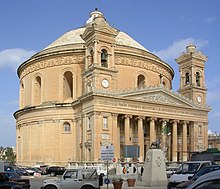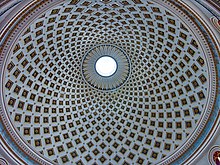 Mosta | ||
| Mosta | ||
| District | Northern District | |
|---|---|---|
| Residents | 20.241 (2014) | |
| height | unknown | |
| no value for height on Wikidata: | ||
| no tourist info on Wikidata: | ||
| location | ||
| ||
Mosta is a city in Northern District of Malta.
background
With around 19,000 inhabitants, the city of Mosta is one of the most populous in Malta thanks to the population growth in the new suburbs.
The region around Mosta has probably been inhabited since prehistoric times, as is evidenced by finds from the Copper Age. The place name probably goes back to the Arabic.
In the Middle Ages there were only about 475 inhabitants in Mosta and the surrounding villages. The community belonged to the near one Naxxar. In 1608 the parishes of Mosta became independent from Naxxar and the church mentioned by the apostolic delegate in 1575 became a parish church.
A chapel already built under the Normans in the 11th century in the center of the village was built in the 17th century and was not consecrated until 1774 after being damaged by the earthquake of 1693. When the population of the town had risen to 3,000 in the early 19th century, a decision was made under Don Felice Calleja in 1830 to build a new church, which resembles the Pantheon in Rome should get. With the active help of the population, the new church with a huge dome was built between 1833 and 1860 Rotunda, built.
getting there
By plane
Most travelers arrive in Malta by plane, from the airport Malta International Airport in Luqa can be reached by bus to the localities in the north of Malta.
By bus
From the airport Luqa can be reached by changing via the bus station from Valletta-Floriana or with the express line X3 with change in Bikirkara to Mosta.
The bus routes 31 / 37 run from Valletta with a detour over Naxxar to Mosta, the line 31 continues after St. Paul's Bay (with Buġibba and Qawra) and the line 37 continue after Mellieħa and to Armier Bay.
The lines 41, 42 and 44 run from Valletta to Mosta and further after Mellieħa and to the ferry port to Ċirkewwa (from there it goes on to Gozo (Lines 41, 42) resp. continue after the Golden Bay resp. Għajn Tuffieħa Bay (Line 44).
By train
There have been no rail links on Malta since 1931.
In the street
From the open area Valetta can be reached on the main road 5 above Msida and Birkirkara on to Mosta.
mobility

The best way to get around locally is on foot.
Tourist Attractions
Rotunda


As 1 Rotunda or Mosta Dome will the Parish Church of the Assumption designated in the center of Mosta. At the site of a church from the Norman era from the 11th century, which was extended by a bell tower in 1614 and consecrated after being damaged by the earthquake of 1693 after a renovation under Tommaso Dingli in 1774, a larger church had to be built in the 19th century due to lack of space .
Because there was a lack of public funding, the residents of Mosta collected for the church and commissioned the Italian-born architect Giorgio Grognet de Vassé to build it. The church with the fourth largest dome in Europe (after St. Peter's Basilica in Rome, the cathedral in Florence and the Pantheon in Rome was built with the active support of the local population in the period 1833/60. For cost reasons, scaffolding even had to be dispensed with. The Rotunda was built around the old church. This was used as a parish church over the decades. The new church could not be consecrated until 1871.
The rotunda is 56.4 m high up to the lantern. The round building has a diameter of 54.9 m, the dome has an inner diameter of 36 m and the towers are 35.6 m high.
The Altarpiece shows the Assumption of Mary and was painted by Stefano Erardi for the smaller parish church and was added in 1860 to be used in the larger frame. During a restoration in 2000, a chain of twelve gold stars was added around Mary's crown.
The statue of the Virgin Mary, which is carried through the city on the feast of the Assumption of Mary, originally came from the local artist Salvatore Dimech and was largely redesigned in 1947 by Vincent Apap.
The Rotunda experienced a dramatic moment on April 9, 1942: four bombs were dropped in the area of the church during an air raid by the Axis powers. One of them broke through the dome and landed on the ground without exploding. Since none of those present was harmed, the inhabitants of Mosta are still grateful for the divine intervention.
Victoria Lines


The Victoria Lines are a defensive line built under British rule, which stretches from the Madliena fortress on the northeast coast of Malta across the island to Fomm ir-Rih Bay. It was supposed to repel a possible attack from one of the bays suitable for a landing maneuver in the north-west of Malta. Only a defensive line resembling a field wall has survived over longer sections.In Mosta you can get to the Victoria Lines by walking around 500 m along the main road north from the Rotunda. After the roundabout you can see the partially restored walls on both sides. To the east you can get right next to this wall to the fort and then walk around it. Duration in one direction approx. 30 minutes.
- The 2 Fort Mosta was built in 1878 as one of the four main fortifications of the Victoria Lines. In the area of the fortress there are early Christian catacombs with an agape table starting from a Punic shaft grave.
- The Targa Battery was built in 1887 to secure the valley cut at Targa.
- The 3 Dweijra Lines were built between 1881 and 1890 in the area of earlier fortifications built by the Johannites, southwest of Bidnija and Zebbiegh.
Chapels
- The chapel 4 San Anton Abbati was built in 1657 in the area of an older building.
- The chapel 5 San Silvestru lies in the Vjal L'Indipendenza and was built in 1664 by the knight Silvestru Fiteni.
- The chapel 6 Madonna tal-Viżitazzjoni / Ta 'Wejda was built in the 16th century in the area of a grotto of the Visitation of Mary and renovated in 1610. As a Latin inscription indicates, the chapel was damaged in World War II in 1944 and reopened in 1965.
- The chapel 7 San Pawl Hermit was in a rock overhang, respectively. a grotto on the slope of the Wied il-Għasel, which dried up in summer, was built around the 16th century in the area of a hermitage. The wasteland was later disrupted when the English built a road to an ammunition depot at the Mosta fortress just above.
- The 8 chapel Ta L'Isperanza / Our Lady of Hope was built over a cave, in which, according to legend, a virgin from Mosta found shelter from persecution by a corsair by hiding behind bushes and cobwebs from the eyes of the pursuers. The renaissance chapel was built in 1760/61 and renovated in 1913. The altar painting is by Rocco Buhagiar.
- The chapel 9 San Pawl tal-Qlejgħa was built in 1690 in baroque style at the old crossing over the Qlejgħa valley.
- The chapel 10 Santa Marija Taż-Żejfi a little further outside of Besbizijja was built in the 16th century and was mentioned in a document in 1610.
activities
- Visit to the city of Mosta
- Hike in the Victoria Lines area
- Participation in the festival "Assumption of Mary" on Aug.
On April 9, 1942, the "Miracle of Mosta" occurred. German fighter pilots accidentally bombed the dome of Mosta Cathedral during an attack on Ta'Qali airfield. The German bomb broke through the dome, but did not explode inside the church, which caused the three hundred believers who had gathered for evening mass to escape with a shock.
The bomb was later defused and is on display in the War Museum in Valletta, in the church there is a bomb similar to the one from April 9, 1942.
The wonderful preservation is commemorated every year with a memorial service.

shop
Daily necessities and groceries are easily available in the supermarkets / mini markets.
kitchen
There are numerous restaurants in the city, from inexpensive take-away to upscale.
nightlife
In the Trik il-Kbira there are several bars.
accommodation
security
health
- in the 1 Mosta Health Center at the Triq Il-Kostituzzjoni tasks of the public health system are fulfilled, this is the closest hospital with an emergency ward Mater Dei University Hospital in Msida / Birkirkara.
Practical advice
- Mosta Local Council, Civic Center, Constitution Street, il-Mosta MST 9059. Tel.: 356 21416841, Fax: 356 21410245, Email: [email protected].
trips
literature
Web links
- http://www.mostalocalcouncil.com/ - Mosta official website
- Website of the Mosta Local Council, engl., maltes.

